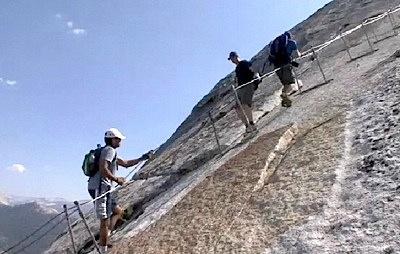The season for hiking to the top of Half Dome in Yosemite National Park officially begins Friday when cables leading to the summit will be put in place...as long as the weather cooperates.
That said, you are required to have a permit to ascend the Half Dome cables seven days per week. The majority of the permits were distributed through a lottery system that ended in March. However, approximately 50 permits per day are available through a two-day in advance lottery. Visitors without a Half Dome permit wishing to hike the cables may enter the lottery two days in advance of their planned day hike by visiting www.recreation.gov or by calling 1-877-444-6777.
For more information regarding the lottery and the Half Dome cables, please visit www.nps.gov/yose/planyourvisit/halfdome.htm.
The trail to Half Dome from Yosemite Valley is an extremely strenuous hike covering more than 17 miles. Hikers gain 4,800 feet of elevation along the trail that passes highlights such as Vernal Fall and Nevada Fall, before reaching the cables on Half Dome's steep granite shoulder. Metal cables and wooden planks are placed along the steep shoulder of the dome to assist hikers to the summit.
Visitors are advised to take appropriate precautions when planning a hike of this length and difficulty, and to be prepared for changing weather and trail conditions. Thunder and lightning are common occurrences in the High Sierra during the summer and fall seasons. Hikers should not attempt to summit Half Dome when rain or thunderstorms are forecasted and are advised to use extreme caution when the rocks are wet.


 Support Essential Coverage of Essential Places
Support Essential Coverage of Essential Places







Comments
This permit business is a disaster. We already saw another death last year where a hiker went up and slipped coming down with rain and mist during her entire ascent and descent. This is what happens when you tell someone that if you make the correct decision to not go up that day, you will not be able to come back the next 2 days, if at all. The system was not broke before the permits were instituted and it certainly has not been made safer. None of the previous accidents had anything to do with high traffic. They had to do with poor decision making as to whether it was safe to ascend or whether the person had the proper footwear and physical/mental strength to ascend.